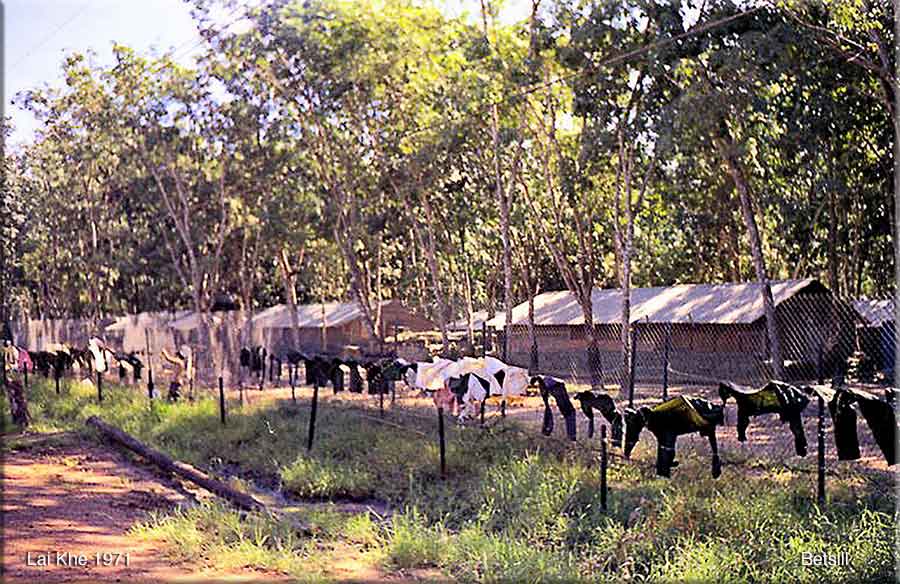

Hamilton, Betsill, Hoag, Borey, Dillon
Tom Hamilton: As the reorganization From D Trp to F Trp was taking place we continued to support the 2nd Brigade until they ceased operations. We were then ordered to move to Lai Khe.
There was a PSP strip, a Vietnamese village on one side adjacent to an ARVN Division and on the other side were some buildings of US construction. As there were hormonally charged young men in the unit and eager to please females across 75 yards of open space, I asked that a ten foot cyclone fence be constructed all around the assigned compound. That revetments for the 26 helicopters assigned be constructed or repaired. We had an extra two float helicopters. The engineers had it done as we moved in. The rifles were assigned internal security for the compound to supplement the ARVN Inf Div.
Carl Betsill: Funny how our recollections differ, but in this case Tom was right. Here is a picture of the concertina wire and the cyclone fence. 
There were plenty of paths around it, however. You could walk from the hooches to the flight line unobstructed. Jim is right however, in that it did not hamper the ladies of the night. They came through the concertina wire between the runway and QL-13 regularly. Everyone on guarding the flight line could see them coming through. Often we would use hand flares to light their way. Higher ups apparently were well aware of this since our orders were to not fire at anyone coming through the wire without radioing and obtaining permission first. Obviously these were orders designed to protect the ladies. Panties and pieces of clothing were often seen hanging on the wire after one of them got tangled sneaking through. BTW, if you want an interesting discussion, talk about Lai Khe’s “steam and cream”.
Jim Hoag: Tom stated in part of his recollections in regards to Lai Khe: There was a PSP strip, a Vietnamese village on one side adjacent to an ARVN Division and on the other side were some buildings of US construction. As there were hormonally charged young men in the unit and eager to please females across 75 yards of open space, I asked that a ten foot cyclone fence be constructed all around the assigned compound. I can guarantee neither a fence nor the concertina wire between the flight line and hootch area kept any of the "eager to please females" (i.e hookers) out of the hootch area at Lai Khe. They came over EVERY night from the village to ply their trade and apparently were pretty successful. They could easily worm their way thru the wire like it wasn't even there.
Don Borey: To add a little about Lai Khe, I recall that for awhile we shared the runway with C 1/9 Cav and, I believe, one other aviation unit ( maybe a 3/17 troop).After the sapper night attack which destroyed several helicopters belonging to C Troop, C and the other aviation unit were pulled out and F Troop alone remained at Lai Khe staying there until January 1972 when we moved back to Long Binh. Several months after the attack, documents were recovered during an ARVN operation that showed the attackers stayed in the Vietnamese village that was on the base and across the runway from the helicopters prior to the attack They remained there several days following the attack before slipping away. Lai Khe, originally the 1st Infantry Division base camp, was under the control of the 5th ARVN with a contingent of US Advisors. A college classmate of mine was the S-1 for the advisory group. We were able to visit several times and I remember going to their O Club a couple of times. The quarters at Lai Khe were really nice. When we moved back to Long Binh, the quarters were quite a come down but a little better than Frensel Jones.
Frank Dillon: I was assigned to A Troop 3/17th October 71 at Lai Khe. They were there, but standing down when F Troop moved to Sanford AAF at Long Binh January 72. I literally walked from my 3/17th hooch to an F Troop Slick and went to Sanford. So, they were the other unit at Lai Khe.